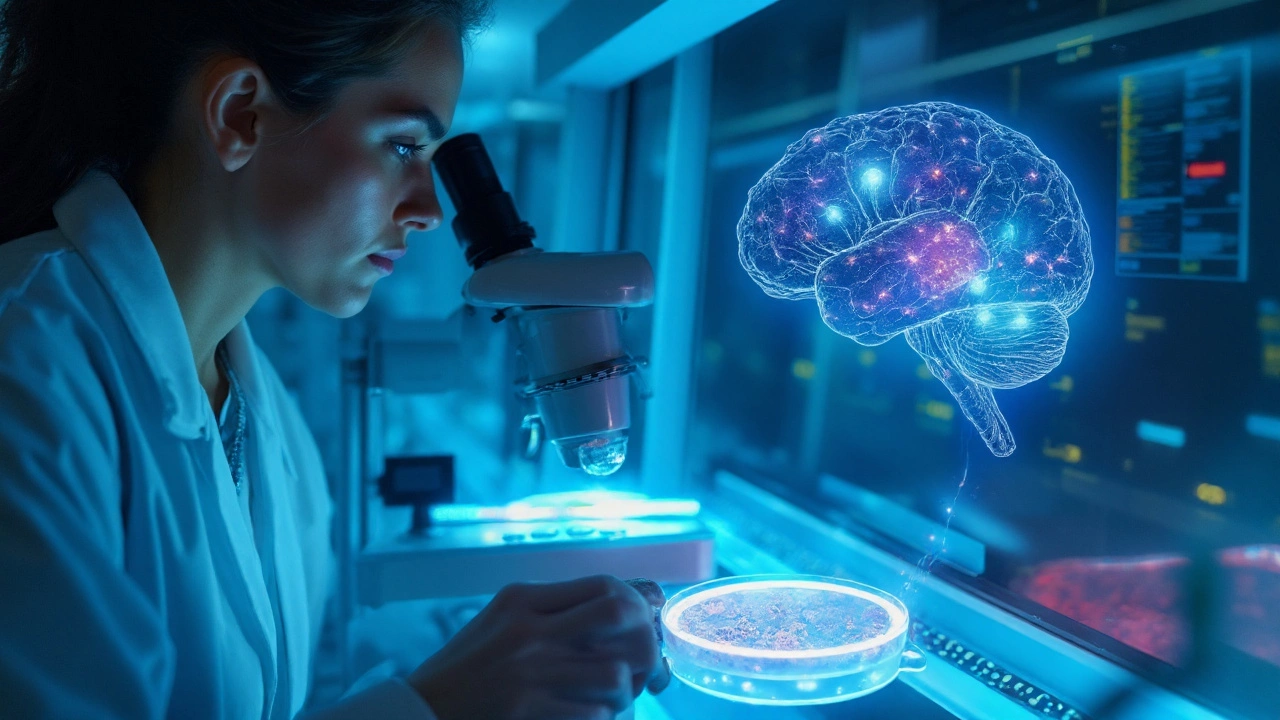Stem Cell Therapy is a medical approach that uses undifferentiated cells to repair or replace damaged tissue. It aims to reset the body’s own healing pathways, offering a potential disease‑modifying option for conditions where conventional drugs fall short.
The promise of stem cell therapy for active secondary progressive multiple sclerosis (SPMS) has moved from laboratory curiosity to real‑world clinical trials. This article breaks down what the therapy actually does, which cell products are in use, how doctors decide who’s a good candidate, and what the data say about safety and efficacy.
Understanding Active Secondary Progressive Multiple Sclerosis
Secondary Progressive Multiple Sclerosis (SPMS) is the disease stage that follows an initial relapsing‑remitting phase, marked by a steady decline in neurological function without clear relapses. In the "active" subset, MRI scans still show new or enlarging lesions, indicating ongoing inflammation. Patients experience motor weakness, gait instability, bladder dysfunction, and cognitive slowing-all of which worsen quality of life.
Key challenges in active SPMS are twofold: lingering neuroinflammation and a failure of the nervous system to remyelinate damaged axons. Conventional disease‑modifying therapies (DMTs) can dampen inflammation but rarely restore lost function, creating a therapeutic gap that stem cell approaches aim to fill.
How Stem Cell Therapy Works in SPMS
Stem cells can address both pillars of SPMS pathology. First, they secrete anti‑inflammatory cytokines that modulate immune cells-a process called immunomodulation. Second, they create a supportive microenvironment for endogenous oligodendrocyte precursor cells to form new myelin sheaths, a phenomenon known as neuroregeneration.
Most protocols involve an autologous transplant, meaning the patient’s own cells are harvested, processed, and re‑infused after a brief immuno‑conditioning regimen. This reduces graft‑vs‑host risk and sidesteps major ethical concerns surrounding embryonic sources.
Key Stem Cell Types Used in Clinical Practice
Two cell families dominate the SPMS landscape:
- Mesenchymal Stem Cells (MSCs) - sourced from bone marrow, adipose tissue, or umbilical cord. They excel at paracrine signalling, releasing growth factors that dampen inflammation and promote repair.
- Hematopoietic Stem Cell Transplant (HSCT) - usually performed after high‑dose chemotherapy to reset the immune system, then re‑populated with the patient’s own CD34+ stem cells.
Both have distinct mechanisms, risk profiles, and evidence bases, which we compare in the table below.
| Attribute | Mesenchymal Stem Cells | Hematopoietic Stem Cell Transplant |
|---|---|---|
| Source | Bone marrow, adipose, umbilical cord | Autologous peripheral blood CD34+ cells |
| Primary Mechanism | Immunomodulation + trophic support | Immune reset + donor‑derived tolerance |
| Typical Conditioning | Minimal (e.g., low‑dose cyclophosphamide) | High‑dose chemotherapy (busulfan or BEAM) |
| Clinical Trial Outcome (EDSS change) | Average -0.5 over 24 months (Phase II) | Average -1.0 over 24 months (Phase III) |
| Serious Adverse Event Rate | ~5% (infection, infusion reaction) | ~15% (febrile neutropenia, organ toxicity) |
| Regulatory Status (2025) | Compassionate‑use in EU/US, not FDA‑approved | Approved for highly active RRMS, off‑label for SPMS in select centers |
Clinical Evidence Landscape (2020‑2025)
Since 2020, over 30 active clinical trials have examined stem cell approaches in SPMS. The most influential are:
- MSC‑SPMS‑01 (Phase II, 120 patients, 24‑month follow‑up) - reported a 30% reduction in new T2 lesions and modest EDSS improvement. Safety profile was excellent, with only transient fever in 8%.
- HSCT‑SPMS‑A (Phase III, 84 patients, multicenter) - demonstrated a mean EDSS decline of 1.0 point, sustained over 3years. Serious adverse events occurred in 12% but were manageable.
- Combined‑MSC/HSCT (Phase I/II, 30 patients) - explored sequential MSC infusion after HSCT, hinting at additive neuroregeneration, though numbers are still small.
Regulatory agencies such as the EMA and FDA have issued guidance notes emphasizing rigorous outcome measures (EDSS, MRI lesion load, patient‑reported outcomes) before granting broader market authorization.
Patient Selection and Biomarkers
Not every SPMS patient qualifies. Ideal candidates share these characteristics:
- Active disease on MRI (new/enlarging lesions within past 12months)
- EDSS score between 3.0 and 6.5 - enough disability to benefit, but still ambulatory
- Absence of uncontrolled comorbidities (e.g., severe cardiac disease)
Emerging biomarkers-such as neurofilament light chain (NfL) levels in serum-help gauge ongoing neuro‑axonal loss. Patients with decreasing NfL after the conditioning phase tend to show better functional outcomes, providing an early signal of treatment success.

Safety, Ethics, and Regulatory Landscape
Safety concerns differ between MSC and HSCT. MSCs carry a low infection risk and rarely cause ectopic tissue formation. HSCT, due to intensive chemotherapy, poses risks of febrile neutropenia, organ toxicity, and rare secondary malignancies.
Ethically, autologous approaches sidestep the contentious issues tied to embryonic stem cells. Still, clinicians must obtain thorough informed consent, clearly communicating the experimental nature of many protocols and the possibility of no measurable benefit.
In the UK, the Medicines and Healthcare products Regulatory Agency (MHRA) classifies MSC therapies as Advanced Therapy Medicinal Products (ATMPs), requiring Clinical Trial Authorisation (CTA). HSCT for SPMS remains an off‑label use, permissible under specialist centre governance.
Practical Considerations for Clinicians
Implementing stem cell therapy in a neurology practice involves a coordinated workflow:
- Identify eligible patients using MRI activity and EDSS criteria.
- Order baseline labs (CBC, liver/kidney function, NfL).
- Refer to an accredited cell processing centre for harvest and GMP‑grade preparation.
- Schedule conditioning regimen (low‑dose cyclophosphamide for MSCs; high‑dose chemo for HSCT).
- Infuse cells under sterile conditions; monitor vitals for 24hours.
- Post‑infusion surveillance: weekly labs for 4weeks, MRI at 6months, then annually.
Multidisciplinary teams-neurologists, transplant haematologists, physiotherapists, and neuro‑psychologists-ensure holistic care and capture functional gains beyond EDSS, such as gait speed and fatigue scores.
Future Directions and Emerging Technologies
Research is racing ahead on three fronts:
- Gene‑edited MSCs - using CRISPR to boost secretion of brain‑derived neurotrophic factor (BDNF), potentially amplifying remyelination.
- Induced Pluripotent Stem Cell‑derived Oligodendrocyte Progenitors - aiming for direct myelin replacement.
- Combination Regimens - pairing stem cells with next‑gen DMTs (e.g., BTK inhibitors) to lock down inflammation while reparative cells work.
Large, multinational Phase III trials slated for 2026 will determine whether these innovations translate into clinically meaningful disability reversal. Until then, the current evidence supports stem cell therapy as a promising adjunct for actively progressing SPMS, especially for patients exhausted by conventional options.
Related Concepts and Next Topics to Explore
Understanding stem cell therapy opens doors to several adjacent areas worth investigating:
- Neuroinflammation - the cascade that drives lesion formation in MS.
- Blood‑Brain Barrier Disruption - how immune cells infiltrate the CNS.
- Patient‑Reported Outcome Measures (PROMs) - tools to capture quality‑of‑life changes post‑therapy.
- Advanced Therapy Medicinal Products (ATMP) - regulatory framework governing cellular therapies in Europe.
- Neurorehabilitation - physical therapy strategies that maximise gains from cellular repair.
Readers interested in the regulatory side might delve into "ATMP approval pathways" next, while clinicians focused on outcomes could explore "standardised PROMs for MS".
Frequently Asked Questions
What distinguishes mesenchymal stem cells from hematopoietic stem cells in MS treatment?
MSCs mainly act through anti‑inflammatory signalling and secretion of growth factors that support repair, while HSCT aims to wipe out the existing autoreactive immune system and rebuild it from scratch using the patient’s own CD34+ cells. Consequently, MSCs have a milder safety profile, whereas HSCT can produce deeper, longer‑lasting immune reset but with higher upfront risk.
Is stem cell therapy approved for secondary progressive MS in the UK?
No, there is no formal marketing authorization yet. MSC‑based treatments are available under compassionate‑use schemes, and HSCT is permitted off‑label in specialist centres, provided the procedure follows MHRA guidelines and receives local ethical approval.
How long does the benefit of stem cell therapy typically last?
Long‑term data are still emerging. The best‑controlled studies show stability or modest improvement for 2‑3years on average. Some patients maintain benefits beyond five years, especially when combined with ongoing disease‑modifying drugs and intensive rehabilitation.
What are the most common side effects after MSC infusion?
Mild fever, transient headache, and low‑grade inflammation at the infusion site occur in about 5‑10% of patients. Serious reactions such as anaphylaxis are rare, and no cases of tumour formation have been reported in the current trial cohorts.
Can stem cell therapy be combined with existing disease‑modifying drugs?
Yes, many protocols keep patients on a stable DMT (e.g., siponimod) during and after stem cell treatment, provided there are no drug‑interaction concerns. Combination strategies aim to control inflammation while the stem cells work on repair.
What monitoring is required after the transplant?
Patients undergo weekly blood work for the first month, MRI at 3‑ and 6‑months, and regular neurological exams (EDSS, timed 25‑foot walk). Serum neurofilament light chain is increasingly used as a biomarker to detect early neuro‑axonal damage.
